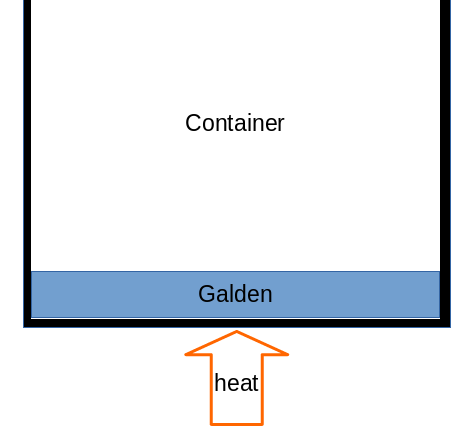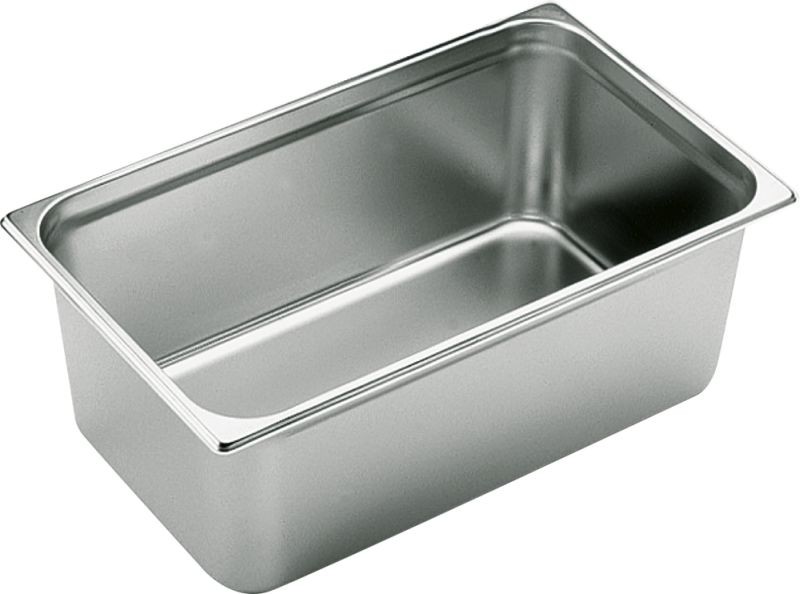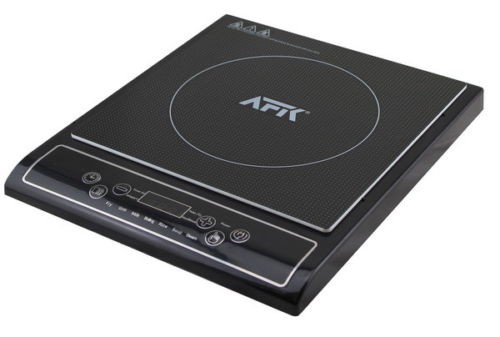So I'll need to get heat into a chamber with galden in it:

Chamber construction
I don't really want to build a chamber from scratch, but rather use something off the shelf and adapt it to my needs.
Gastronorm container
The first idea was to use one of these standardized containers used in gastronomy (they're called "gastronorm" containers):

There are many sizes and heights available. The size is derived from the basic "1/1" size, which is 530 x 325 mm outer dimension. That's of course too large for this purpose, but size 1/4 (265 x 162 mm) might be right. The largest standard height is 200 mm. These can be had in stainless steel for about 15 € (incl shipping). Possible drawback: I'm not sure how flat the bottom is. If it's not flat, this might be a problem when trying to heat it from below. gastronorm containers with a massive, flat bottom are available, but expensive (150 € at least).
A Pot
An alternative is a standard pot you'd find in your kitchen. Comes with a flat bottom, but usually also with a round cross section. Height around 200 mm is absolutely normal and the price won't hurt: 20 to 30 € for a cheap one, and cheap will suffice.
Heating
Heat! The end of the exergetic food chain comes in many forms and so the list of ways to heat the chamber is long. I'll start the list with internal, immersed heaters.
Immersed cylindrical heating element
Some of these would do the job:

They are available in many sizes, down to about 4 mm, and some even include an internal temperature sensor. Connecting wires would have to escape to the top through the chamber. That is not a drawback per se, but the wires' stiffness might be. I would want the heaters to be as close to the bottom as possible, because the higher they are from the bottom, the more liquid galden has to be in there. Stiff wires would simply make it harder to get the heaters to stay flat on the bottom. Letting the heaters run "dry" might overheat galden beyond the allowed temperature where it starts to dissociate into nasty stuff like HF. The heating surface isn't very large to start with, so the danger of overheating at the shell/liquid boundary is relatively large.
Immersed heating pad
This:

Silicone heating pads also come in a few sizes, but they are expensive. Sticking one to the bottom of the chamber with liquid galden around also doesn't sound like an easy to implement idea. Again, sturdy wires through the chamber that might ruin the show (see above).
External heating pad
Same price as internal, but might be easier to handle and attach to the chamber. Textile versions are also available, but similarly expensive. It might be possible to laminate a heating pad directly on the chamber's outside using glass fiber, flat nichrome wire and 2-component silicone, though. Surely an interesting endeavor and a project just by itself, especially with the lessons learned from the #Carbon/silicone hotplate fail.
Hot plate (resistance or halogen)
Only available when the chamber has a flat bottom. Simple hot plates can be wired into the control system and are readily available for little money.
Hot plate (induction)
There are cheap induction plates, some as low as 20 €:

The same model is used by many brands and I guess it might be possible to hack it into the control system (but that's something I wouldn't want to try). One advantage would be that induction is fast, and the plates have an internal temperature sensor for the pot on top. Again, chamber must have a flat bottom, which narrows down the options to induction compatible pots.
One more thought about control: Setting the plate to a certain temperature (the one shown above is marketed with a temperature mode ranging from 80° to 270° C) and then simply cutting power with a relay would at least make it possible to limit the overall thermal energy in the system. The controller could then try to make use of what's there.
Shrink fit (induction from the sides)
@Bharbour pointed out that it might be possible to use induction for heating, and he had this variant in mind. Cheap induction controllers on ebay can be used to supply a coil that is wound around the chamber, but as you might have guesses: Lots of galden required, and the chamber material must meet certain requirements for this to work. I've only seen this for shrink fit tool holders, but indeed they get hot so the principle is good for this purpose as well.
Hot air
Why not just point a hot air gun at the bottom? That might work indeed (with a gastronorm container, thanks to the thin bottom) but any heat that is not transferred to the chamber is a) lost and b) must be guided to an outlet and then - then what? Sounds dangerous since the air will have up to 300 °C during operation. So that leads us to the next option:
Hot air with recirculation
Just like in a convection oven, a fan is used to move air to a heater, from there to the chamber's bottom and then back to the fan. The hot air would stay inside the system and less energy is lost through the dangerous outlet. However, the heating element would probably have to be custom made and (the harder part) the moving parts must withstand high temperatures or get some cooling. This has been done (see household appliances), but certainly not without a significant amount of tricks and special parts.
Radiation!
Just placing a couple of halogen bulbs below a gastronorm container (thin bottom) is certainly cheap and simple to control. However, there's a risk of overheating both the galden and the bulbs, but people reflow PCBs directly with a 500 W halogen lamp and get away with it. Installing a temperature sensor at the bottom wouldn't be too hard anyway.
Bottom line: there's a rather hard line between types of heating that allow for a non-flat bottom and those that require a flat one.
 Christoph
Christoph
Discussions
Become a Hackaday.io Member
Create an account to leave a comment. Already have an account? Log In.